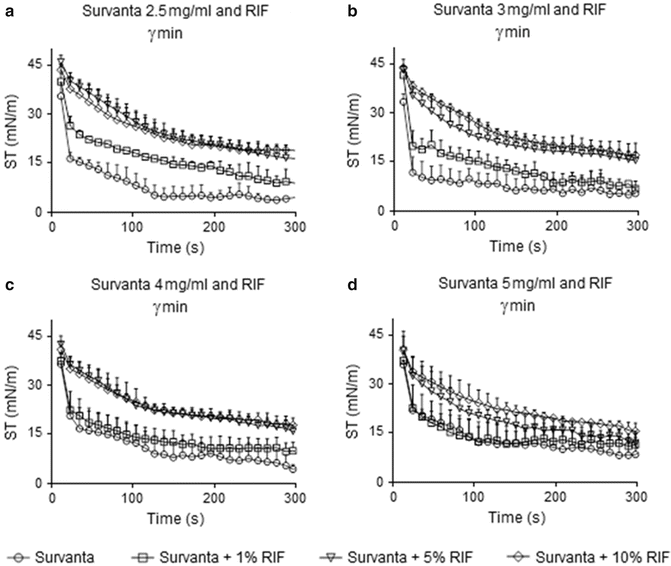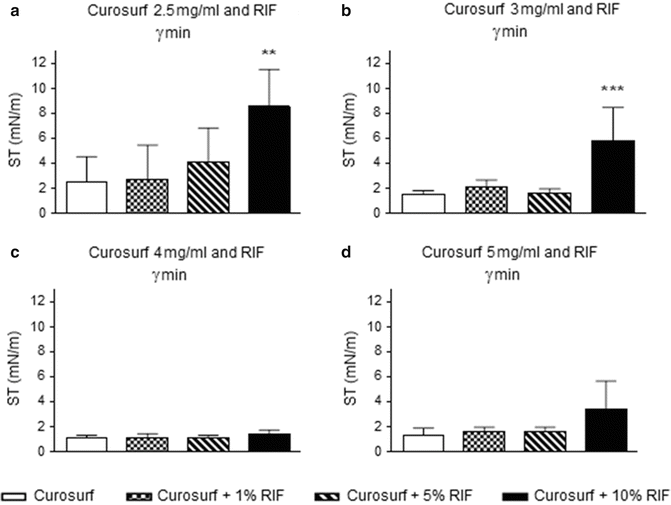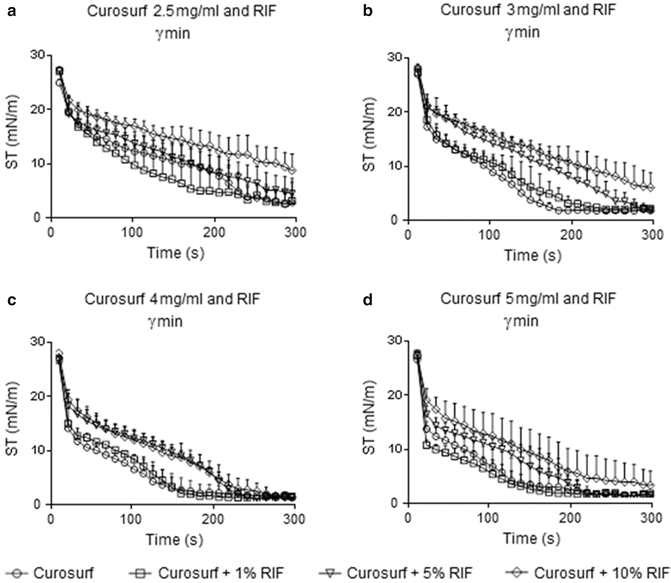Fig. 1
Minimum surface tension (ST; γmin) of Survanta at concentration 2.5 mg/ml (a), 3 mg/ml (b), 4 mg/ml (c), and 5 mg/ml (d) with or without rifampicin (RIF) 1, 5, and 10 % (w/w) after 5 min in pulsating bubble surfactometer. Values are means ± SD. *p < 0.05 and ***p < 0.001 vs. Survanta (open bar)

Fig. 2
Minimum surface tension (ST; γmin) of Survanta 2.5 mg/ml (a), 3 mg/ml (b), 4 mg/ml (c), and 5 mg/ml (d) with or without rifampicin (RIF) 1, 5, and 10 % (w/w) across the whole period (5 min) of cycling in pulsating bubble surfactometer. Values are means ± SD
γmax of Survanta without RIF at all phospholipid concentrations was higher than optimal. After addition of RIF at 1, 5 and 10 % γmax remained high; however, a concentration-dependent stabilizing effect of RIF on γmax during 5 min of pulsation could be seen.
3.2 Curosurf/RIF Mixture
Minimum surface tension (γmin) with 10 % RIF was significantly higher only at a Curosurf concentration of 2.5 mg/ml (p < 0.05 vs. Curosurf) and 3 mg/ml (Fig. 3a, b) (p < 0.001 vs. Curosurf). Addition of RIF at any concentration to Curosurf at 4 and 5 mg PL/ml (Fig. 3c, d) did not influence γmin that remained <5 mN/m in all Curosurf/RIF mixtures. The dynamic changes of γmin of Curosurf alone and different Curosurf/RIF mixtures during the whole cycling period are shown in Fig. 4a–d.



Fig. 3
Minimum surface tension (ST; γmin) of Curosurf at concentration 2.5 mg/ml (a), 3 mg/ml (b), 4 mg/ml (c), and 5 mg/ml (d) with or without rifampicin (RIF) 1, 5, and 10 % (w/w) after 5 min in pulsating bubble surfactometer. Values are means ± SD. **p < 0.01, and *** p < 0.001 vs. Curosurf (open bar)

Fig. 4
Minimum surface tension (ST; γmin) of Curosurf 2.5 mg/ml (a), 3 mg/ml (b), 4 mg/ml (c), and 5 mg/ml (d) with or without rifampicin (RIF) 1, 5, and 10 % (w/w) across the whole period (5 min) of cycling in pulsating bubble surfactometer. Values are means ± SD
The γmax of Curosurf without RIF at all phospholipid concentrations was at comparable level and it was in accordance with values common for in vitro experiments at tested PL concentrations. Addition of RIF led to a significant increase in γmax at all RIF concentrations with the highest power at 10 % RIF. Nevertheless, γmax of Curosurf/RIF mixtures remained under 40 mN/m.
4 Discussion
This study investigated the influence of rifampicin on in vitro function of two animal-derived pulmonary surfactant preparations in order to assess the mutual interaction with surface tension during the use of surfactant as a pulmonary drug delivery system. We evaluated whether γmin of the antibiotic/surfactant mixture was comparable to the γmin of the surfactant alone. In general, the rate of adsorption was reduced with increasing concentration of RIF (Figs. 2 and 4). After 5 min of pulsation, the γmin was <5 mN/m even when 10 % RIF was added to Curosurf at 5 mg PL/ml (Fig. 3a–d). With Survanta at 2.5–4.0 mg/ml, a typical concentration-dependent manner of inactivation was seen at all RIF’s concentrations (Fig. 1a–c). Survanta at 5 mg/ml was significantly inactivated only with RIF 10 % (Fig. 1d). However, even at lower RIF concentrations (1 and 5 %) the γmin was >10 mN/m. It was not different from the γmin of Survanta alone, and it was over 5 mN/m, a value indicating a good biophysical activity.
The reason why RIF interferes differently with Curosurf and Survanta is probably based on the differences in their chemical composition, due to different sources and the methods used to process the surfactant material (Blanco and Pérez-Gil 2007). Survanta is made from minced bovine lung extract, with the addition of DPPC, palmitic acid, and triacylglycerol. Curosurf is an extract of whole mince of porcine lung tissue purified by column chromatography. These two surfactants are primarily lipid (>98 %), they contain small amounts of surfactant proteins SP-B and SP-C, and no SP-A and SP-D (Table 1) (Braun et al. 2007; Bernhard et al. 2000; Robertson and Halliday 1998). The resulting proportion of the main surface active lipid component, DPPC, varies from 70 % in Survanta to 56 % in Curosurf (Bernhard et al. 2000). The presence of minor surfactant lipids containing polyunsaturated fatty acids (PUFA), cholesterol, and plasmalogens may influence the rheological properties of surfactants (Rüdiger et al. 2005). The low proportion of plasmalogens, PUFA containing phospholipids, and cholesterol in Survanta causes that a low surface tension is reached, when surface viscosity is relatively high. Curosurf has a higher percentage of PUFA compared with Survanta and therefore, a lower surface viscosity (Rüdiger et al. 2005).
Table 1
Lipid composition (%, g/g of total lipid) and protein concentration (% phospholipid, g/g) of native surfactant and two-animal derived preparations
Native surfactant | Curosurf® | Survanta® | |
|---|---|---|---|
PC % (w/w) | 70–85 | 67–74 | 79–87 |
DPPC (%PC) | 36–54 | 50–56 | 45–75 |
PG | 7–10 | 1.2 | 3.2 |
PI | 4–7 | 3.3 | 0.5 |
PE | 3 | 4.5 | 2.2 |
Sphingomyelin | 2 | 8.1 | 4.8 |
Cholesterol | 5 | 0 | 0 |
LPC | 0.5 | <1 | 1 |
PA | 6–14 | ||
SP-B | 1 | 0.3 | 0.04–0.13 |
SP-C | 1 | 0.7 | 0.9–1.65 |
Regarding the proteins, clinical surfactants obtained from natural sources are characterized by a relatively low content of SP-B compared with that in native surfactant. Survanta that has a lower SP-B content than Curosurf and presents in vitro lower interfacial adsorption activity and higher γmin. A lower content of SP-B and higher viscosity at 5 mg of phospholipids/ml could be a reason why pure Survanta in our experiments did not reach the γmin less than 5 mN/m (Fig. 1d).
Stay updated, free articles. Join our Telegram channel

Full access? Get Clinical Tree


